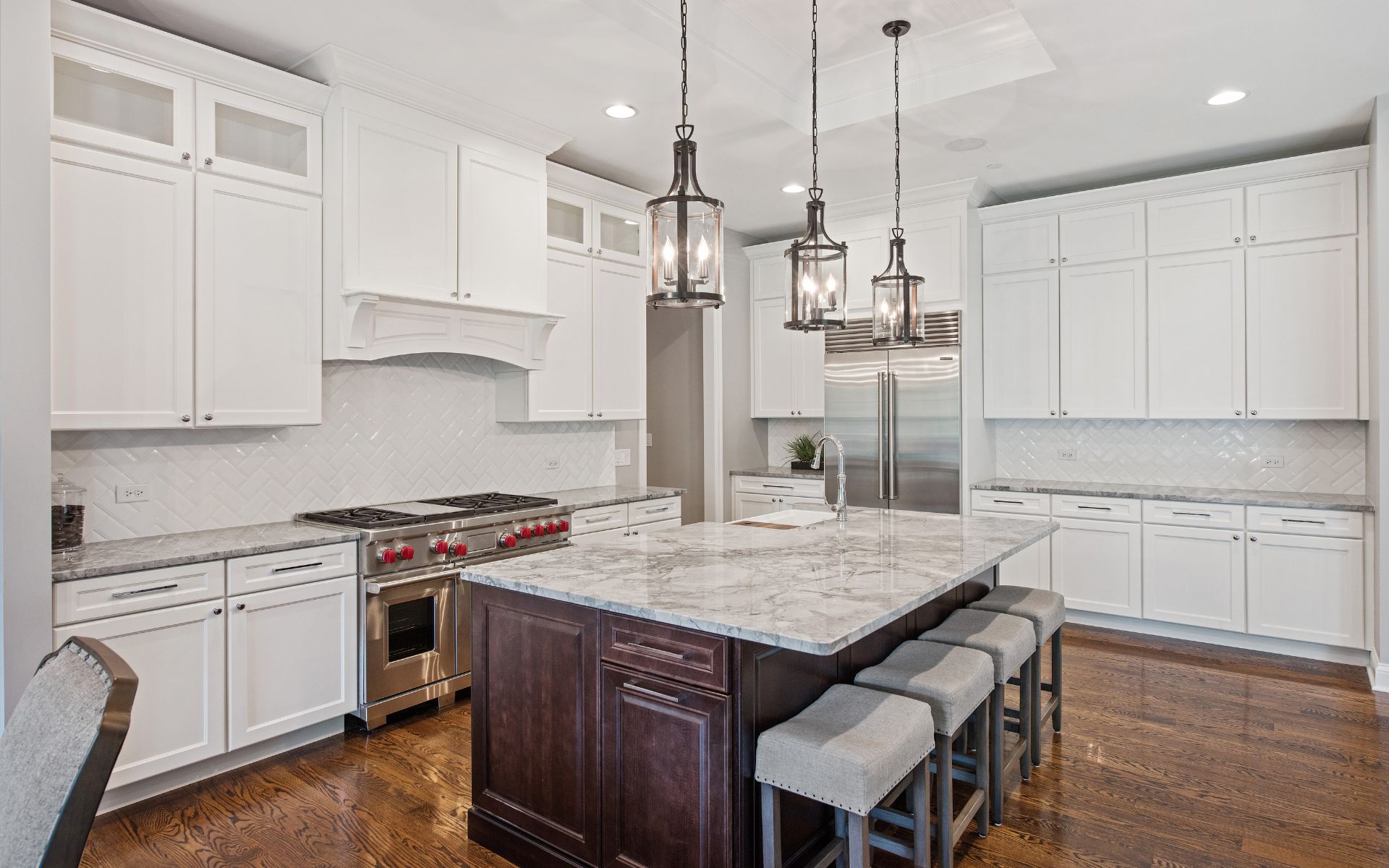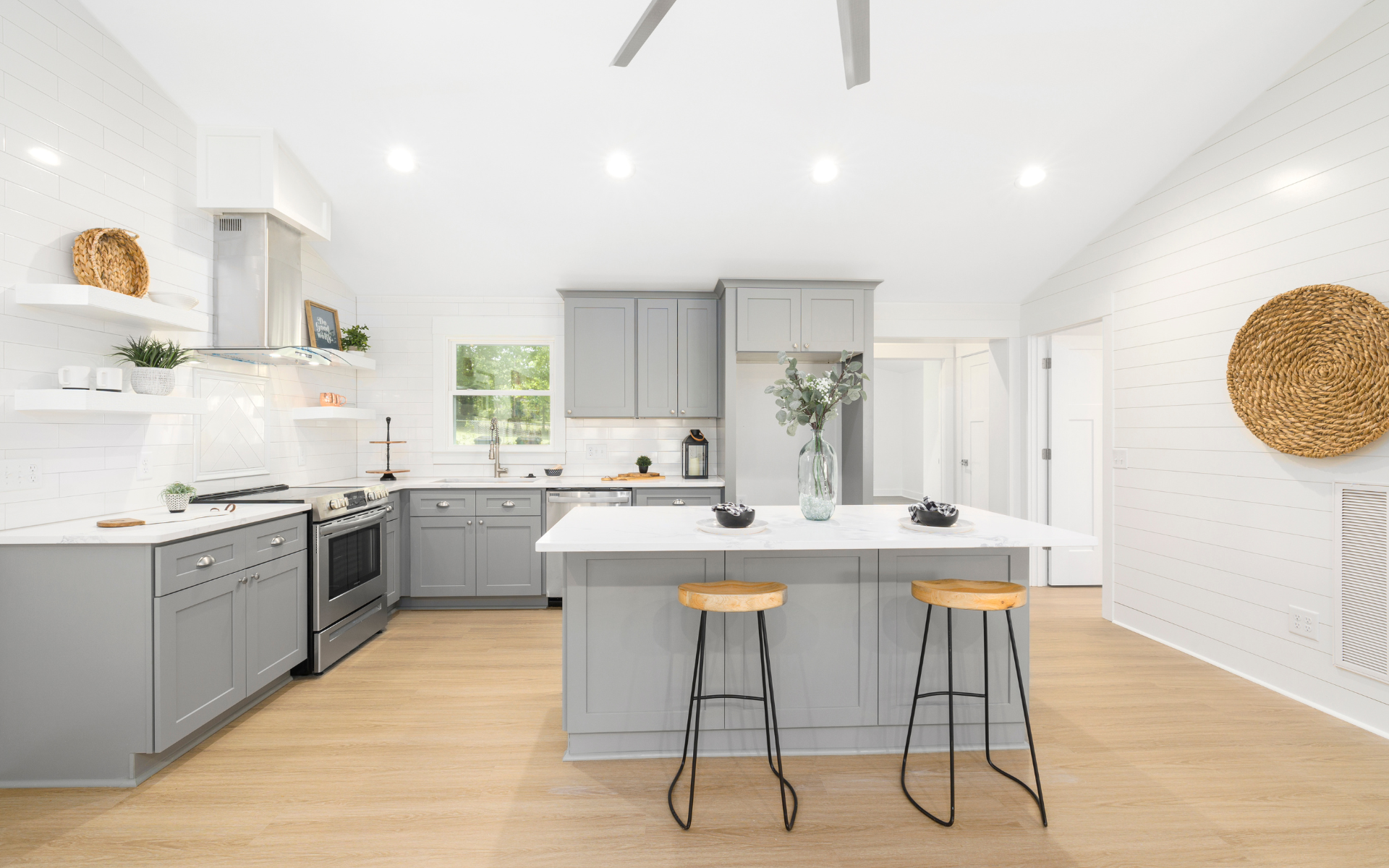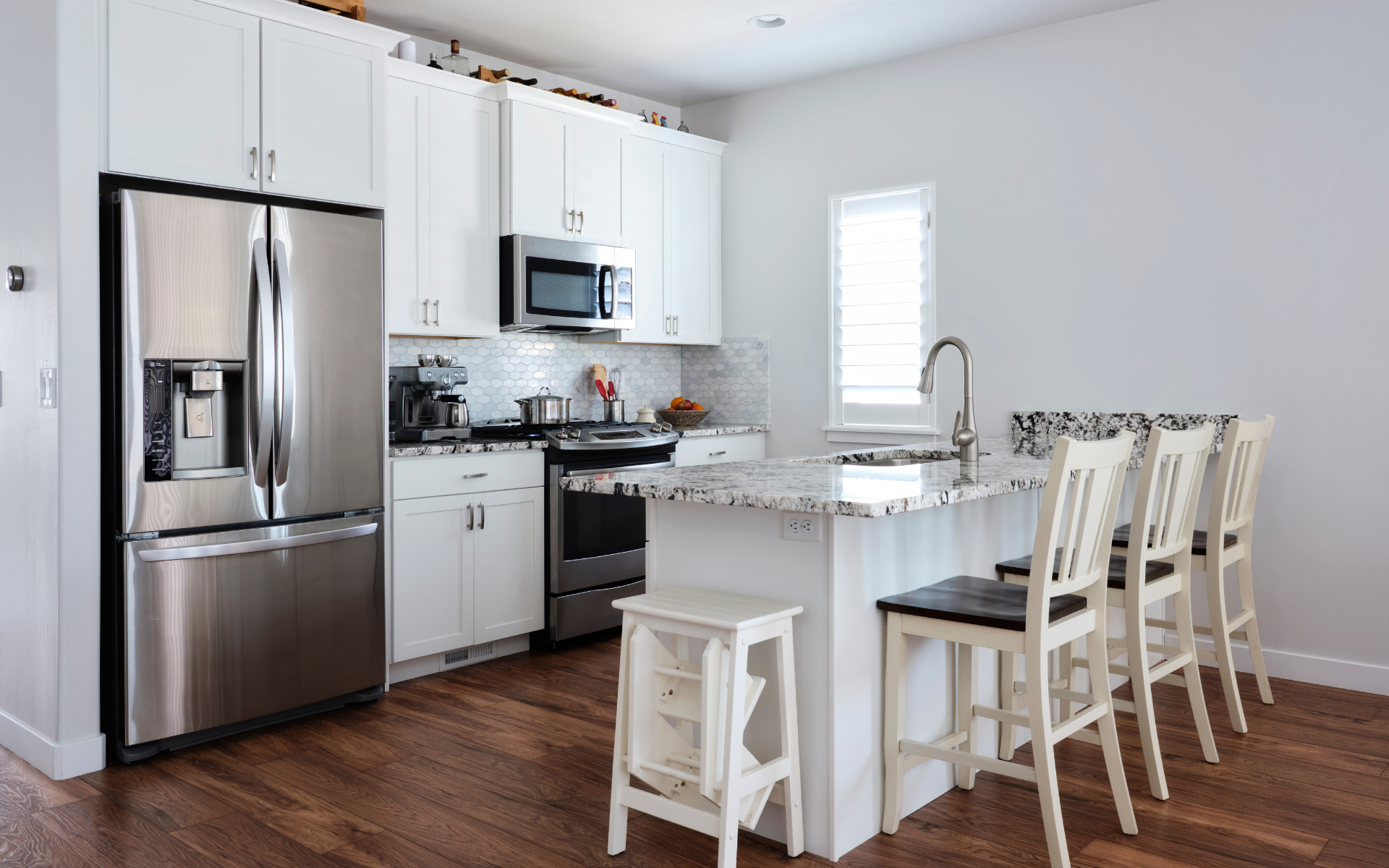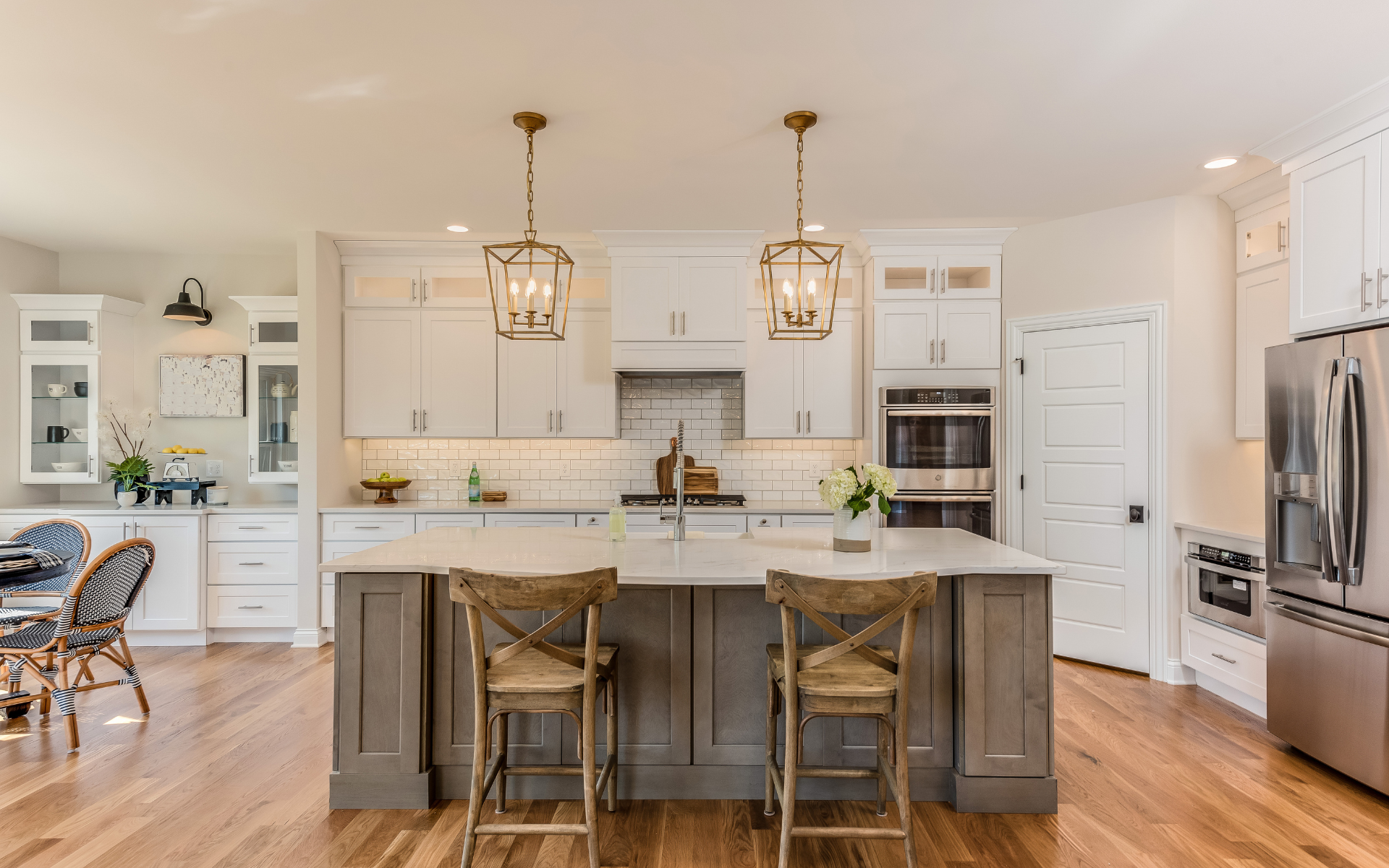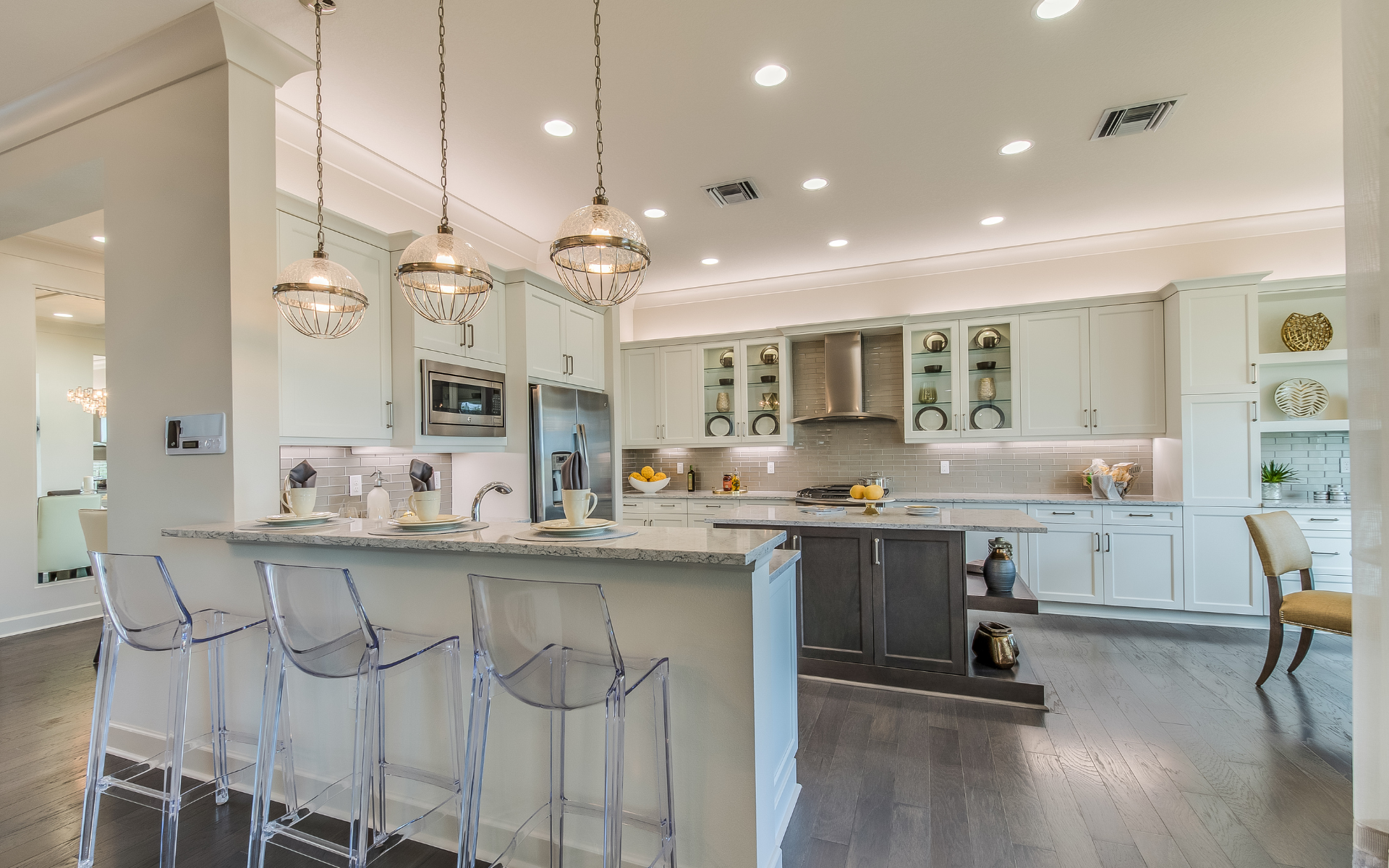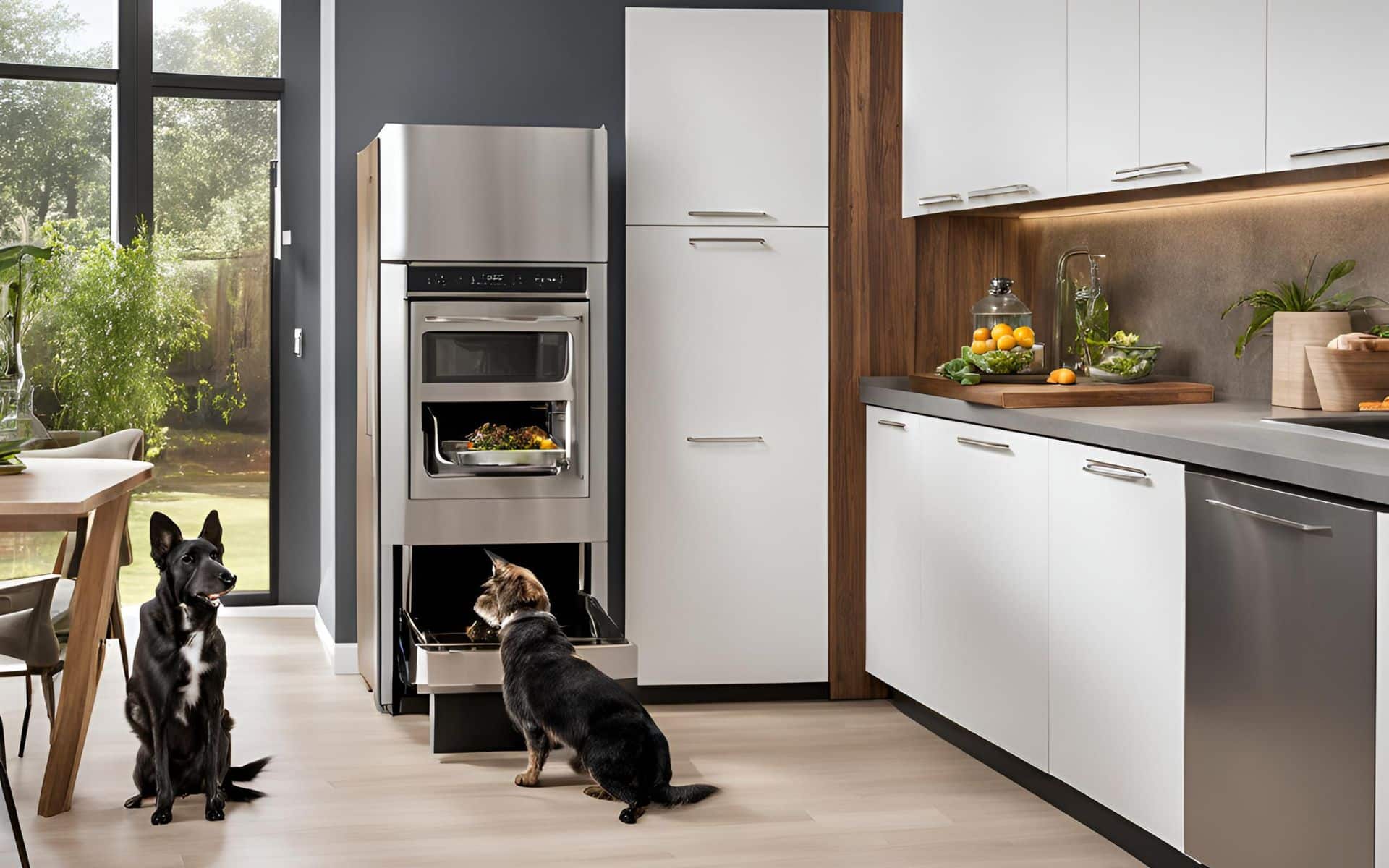Are you looking to remodel your kitchen and bath and would like to make some additions to enhance the look? Well, if you want to focus more on your kitchen, a good addition could be a kitchen island. But, what works better? Here’s a comparison between Kitchen Island vs Peninsula. Both can enhance the look and function of your kitchen, so how do you choose what’s best?
We’ll compare kitchen islands and peninsulas to highlight the differences and help you decide which option makes sense for your home. Read on for advice from design experts on optimal kitchen layouts and things to consider from workflow to costs.
What Exactly Is a Kitchen Island?
A kitchen island is a freestanding counter and cabinet area in the center of the kitchen floor plan. Islands can provide more usable counter space and storage, and become a natural gathering spot in open-concept kitchens.
In technical terms, islands are detached from other cabinets and surfaces on all sides. They have a 360-degree walkway so you can easily access the island from any direction.
Islands come in a wide range of sizes, from compact islands with only a little bit of counter space to large islands that can comfortably seat six or more guests. The size you choose depends on your kitchen footprint and how you plan to utilize the island.
Some key characteristics of kitchen islands:
- Freestanding unit with 360° walkway
- Provides more usable counter space
- Can incorporate additional storage, and appliances
- Often used for casual dining and entertaining
Defining the Kitchen Peninsula
A kitchen peninsula is similar to an island in that it provides extra counter space and storage. The distinction is that a peninsula is connected to other cabinetry or walls on one side, leaving access from three sides instead of four.
So while an island is detached, a peninsula extends out from another surface like cabinets or a wall. Picture an I shape (island) versus a U shape with a longer base (peninsula).
Peninsulas tend to separate kitchen zones, like dividing a cooking area from an eating area while still allowing you to move easily between the two. They also lend themselves well to creating efficient kitchen work triangles.
Definition of a kitchen peninsula:
- Connected to cabinets/walls on one side
- Accessible from three sides
- Helps delineate kitchen zones
- Supports efficient work triangles
Comparing Kitchen Island vs. Peninsula
Islands and peninsulas serve similar purposes, so how do you determine which is better suited for your kitchen remodel? We’ll outline the distinct pros and cons of islands and peninsulas next.
Kitchen Island Pros and Cons
Benefits of adding a kitchen island include:
- Provides more readily accessible counter space for food prep and serving
- Opens up opportunities for casual dining and entertaining space
- Allows traffic to move freely around the perimeter, enhancing flow
- Serves as a natural gathering spot in open-concept floorplans
- Adds storage without claiming wall space or feeling cramped
However, there are a few potential downsides with islands to note:
- Islands can limit space for multiple cooks by blocking traffic routes
- May encroach on room required for table/seating areas
- Don’t necessarily improve work triangles the way peninsulas can
- Adds cost for the extra cabinetry and countertops
Kitchen Peninsula Pros and Cons
Looking at peninsulas, the pros include:
- Allows for efficient kitchen work triangles for cooking
- Visually separates kitchen zones like eating vs. food prep
- Offers privacy if positioned to block views from other rooms
- Costs less than an island in most cases
- Takes up less overall floorspace than an island
Peninsulas do come with a few disadvantages:
- Access only from three sides limits mobility compared to an island
- Could make the room appear smaller if poorly positioned
- Doesn’t provide as much open gathering space
- Requires adequate wall or cabinet space to attach the peninsula
Key Considerations: Size, Layout & Workflow
Determining if an island or peninsula makes the most sense involves looking at your kitchen size, layout, and intended workflow patterns. We’ll break down what design experts recommend.
Factor #1: Kitchen Size & Dimensions
How much floor space do you have to work with? Islands need substantial open areas to allow sufficient walkway access.
Recommended island size guidelines:
- 36-42 inches wide to allow single-cook access
- 48-60 inches or wider to accommodate multiple cooks
- Allow at least 42-48 inches surrounding the island as a walkway
Meanwhile, peninsulas can extend out from existing walls and cabinets, requiring less open floor area. Just ensure there’s adequate walkway space left for circulation.
If your kitchen is on the smaller side, a peninsula likely makes more sense than squeezing in an island. You want to avoid bottlenecks or limited counter space due to overcrowding.
Factor #2: Existing Kitchen Layout
What’s your current kitchen layout? Consider the existing cabinet configuration, appliances, windows, and doors that impact available space.
For example, if you have U-shaped cabinets on three walls, extending one side to form a peninsula may be easier than adding an island. Or if you have a galley or L-shaped kitchen, an island could help define zones better.
Also, look at transitions into other rooms. An island could impede flow in narrow openings, whereas a thoughtfully placed peninsula can help divide spaces.
Factor #3: Kitchen Work Triangle
The work triangle concept focuses on optimizing distances between key zones:
- The sink
- Cooktop
- Refrigerator
Experts recommend:
- Each triangle leg spans 4-9 feet with no more than 26 feet in total
- Triangle corners should have 60-120-degree angles
- Avoid overlaps that cause bottlenecks
Islands and peninsulas impact triangle efficiency differently:
- Islands: Don’t directly impact work triangles since they’re freestanding
- Peninsulas: Allow you to design optimal work triangle angles/distances if placed properly
So if you’re remodeling to improve kitchen workflow, a peninsula likely adds more functionality.
Design Inspiration: Creative Island & Peninsula Ideas
Need some visual inspiration on how to effectively incorporate an island or peninsula? Here are some stellar kitchen remodeling ideas for you.
Open Concept Kitchen Island Ideas
In wide-open concept spaces, a sizable island makes a natural gathering spot and communal workspace.
Spacious Farmhouse Island
This farmhouse kitchen island has room for four barstools, enhancing the sociable open floorplan. The white shaker cabinets brighten up the space and match the cabinetry stretching across the back wall.
Key Takeaways:
- Contrasting island color/style adds interest
- Substantial seating capacity enables gatherings
- Open shelves bring visual balance
Modern Industrial Island
Exposed beams, pendant lights, and concrete floors give this kitchen an urban industrial vibe. The dark gray island provides ample seating as part of the open dining space.
Key Takeaways:
- Contrasting finishes add interest
- Waterfall island edges for clean sightlines
- Open shelving ties spaces together
Galley & U-Shaped Peninsula Inspiration
For galley and U-shaped kitchens, a thoughtfully placed peninsula can optimize the layout.
Compact Galley Peninsula
This galley kitchen uses every inch wisely. The peninsula extending from the lower cabinetry creates additional prep space and casual seating without cluttering the compact floor plan.
Key Takeaways:
- Peninsula width suits smaller kitchens
- Added storage below seats
- The peninsula overhang allows for seating
U-Shaped Peninsula with Walkthrough
This clever U-shaped design takes advantage of an unused nook to create extra storage and prep space. The walkthrough peninsula limits bottlenecks.
Key Takeaways:
- Walkthrough peninsula avoids tight corners
- Makes use of an angled nook
- Adds storage and counter space
Cost Comparison: Island vs Peninsula
Whether building a new construction kitchen or renovating an existing space, cost plays a key role in deciding between an island or a peninsula.
Peninsulas generally cost 15-30% less than islands since they utilize existing cabinetry or walls on one side. Islands require constructing cabinet boxes and countertops on all sides, increasing material expenses, labor, and installation time.
However, precise costs depend on factors like:
- Island/Peninsula Dimensions: The overall size of your island or peninsula significantly impacts costs. Larger islands require more materials and construction labor. Standard depth is 25-26 inches, but wider islands allow more usable space. Extension length also bumps up costs for more countertop and cabinet square footage. Carefully measure your space and map out appropriate dimensions.
- Cabinet Finish Selection: Islands and peninsulas both utilize cabinetry that comes in a wide range of quality and price points. Opting for custom-built over stock, premium woods over cheaper lumber, and upgraded doors/drawers over basic versions greatly increases project expense. Weigh aesthetics, durability, and budget when choosing finishes.
- Countertop Material: Common island/peninsula countertop materials like granite, quartz, and marble range dramatically in cost per square foot installed. Durability and ease of maintenance also vary. Get quotes on a few stone types you like to determine countertop costs.
- Appliance Integration: Adding appliances like sinks, cooktops, or fridge drawers drives up costs for necessary plumbing, electrical, ventilation, and installation. But integrated appliances also enhance functionality, so weigh priorities. Consider appliance sizes and placements early on.
- Seating Size and Features: Incorporating seating on islands or peninsulas increases project costs, especially larger capacities. Built-in stools need framing, covers, and cushions. Features like electrical outlets or under-mount lighting also add expenses that quickly accumulate.
- Storage Configuration: Islands and peninsulas allow specialized storage options like pull-out shelves, racks, or drawers. The more customized storage, the higher the price tag. However, enhanced organization and access can outweigh added costs for avid cooks.
- HVAC, Plumbing, Electrical: Any mechanical systems needed, like added venting for cooktops or installing plumbing for extra sinks, increase project costs. Electrical for lighting, outlets, and appliances also add up. Have pros assess required updates early in planning. They can provide accurate estimates for mechanicals.
Talk to your designer early when budgeting a kitchen project. They can provide accurate estimates for potential island or peninsula builds.
It’s also smart to allocate 10-15% extra for inevitable surprises that pop up during remodeling. Having a contingency cushion makes it less likely you’ll feel forced into downgrading finishes or sizes due to ballooning costs.
Which Is Better for Resale Value?
Beyond personal preferences, resale value impacts many homeowners’ decisions between islands and peninsulas. But which adds more value long-term?
According to the National Association of REALTORS®, the more usable counter space and storage a kitchen provides, the higher the home resale value.
Since islands inherently provide more prep space and storage capacity than peninsulas, they tend to net a higher return on investment.
Surveys by the National Association of Realtors (NAR) reveal over 80% of home buyers find kitchen islands highly appealing and crucial for resale value
So if you ever plan to sell, an island is the smarter choice for boosting equity and buyer appeal. Just be sure to design proportions suitable to your home’s size. An overcrowded island can deter buyers.
The Final Decision: Island or Peninsula for Your Kitchen?
Have you decided whether an island or peninsula better suits your kitchen remodel after comparing the pros, cons, and costs?
Keep these key takeaways in mind as you evaluate options:
- Islands maximize prep space, storage, and gatherings
- Peninsulas simplify work triangles and use layouts efficiently
- To pick the right size, balance ergonomics with open-flow
- Carefully weigh layout, traffic patterns, and intended uses
- Budget 15-20% extra for contingency costs
Weigh what’s most important for your household in terms of function and lifestyle. Do you regularly host large gatherings needing open seating? Or would a defined work zone for serious cooking suit you better?
Finding the right design professionals can also help transform your vision into reality. Schedule consultations with qualified kitchen designers and contractors to discuss project scoping, budgeting, and ideas.
Feel free to reach out with any additional kitchen island or peninsula questions. We’re always happy to help you work through the planning process to create your perfect kitchen space!

